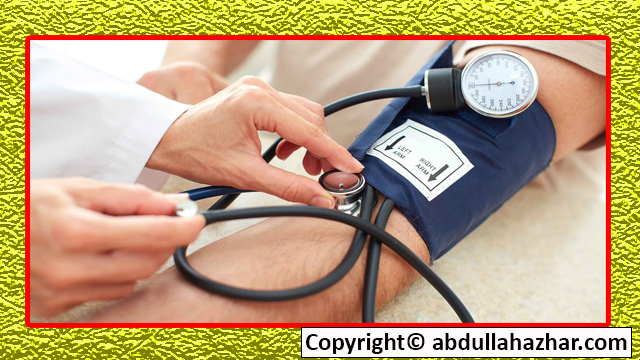Worldwide, an estimated 128 billion adults between the ages of 30-79 experience violence, with the majority of them (two-thirds) residing in low- and middle-income nations.

Violence is experienced unknowingly by 46% of adults with high blood pressure. problem. Only 42% of adult patients with high blood pressure receive a diagnosis and treatment. Adults with high blood pressure make up about 21% of those who can control their blood pressure.
BODY PRESSURE
- Age in advance.
- Genetics.
- Having an excessive or obese weight.
- Breathing.
- Adding excessive salt.
- Overindulging in alcohol.
- Lifestyle adjustments, such as adopting a healthy diet, managing high blood pressure, and cutting back on alcohol and smoking.
- Some individuals still require medication.
Blood Pressure is Measured
10 with two digits Systolic blood pressure, which is represented by the first number, gauges the pressure in the arteries as the heart beats.The pressure in the arteries at heart rate is indicated by the second number, diastolic pressure.
If the two-day systolic and/or two-day diastolic readings are taken on two different days, hypertension is considered to be present.
Risk
Malnutrition (healthy diet, high-fat diet, low fruit and vegetable intake), physical inactivity, smoking and alcohol use, and being overweight or obese are among the risk factors that can be modified.
Symptoms
Checking your blood pressure is the best way to find out if you have high blood pressure.
High blood pressure can cause kidney disease, heart disease, and stroke if it is not treated. It can also cause other health issues. The following symptoms may be present in people with high blood pressure (typically 180/120 or more).
- Headache.
- A pain in the chest.
- Dizziness.
- Breathing difficulty.
- Nausea.
Vomiting, a cold, bleeding blood, and four.
Abnormal heartbeat 44 44 If you have these symptoms in addition to high blood pressure, get help right away.
A doctor’s blood pressure reading is the only way to determine if you have high blood pressure.
Despite the fact that people can measure their own blood pressure using automatic devices, it’s critical that a doctor assess the risk and event assessment.
Treatment
Blood pressure can be decreased by making lifestyle changes. These include.
- A balanced, low-sodium diet.
- Slimming down.
- Exercise.
Give Up Smoking
Your physician might prescribe one or more medications if you have high blood pressure. Your other medical conditions will determine the recommended blood pressure target for you.
- If your desired systolic pressure is less than 130/80:.
- Cardiovascular disease (Heart attack or stroke) .
- Hyperglycemia, or diabetes.
- Disease of the kidneys.
- Heart disease is a high risk.
Systolic blood pressure is most commonly desired to be under 140/90.
To lower systolic pressure, many different medications are frequently used.
Enalapril and lisinopril are ACE inhibitors that relax blood vessels and protect kidneys.
Vascular relaxation and protection against kidney damage are two benefits of angiotensin 2 receptor blockers (ARBs), such as losartan and telmisartan.
Amphetamines and felodipine are examples of calcium channel blockers that relax the arteries.
By flushing out extra water from the body, diuretics like chlorthalidone and hydrochlorothiazide lower systolic pressure.
Prevention
- Anyone with high systolic pressure can benefit from lifestyle changes in lowering their blood pressure.
- Boost your fruit and vegetable intake.
- Standing or sitting.
- Physical activity, including arduous exercises like running, swimming, dancing, or weightlifting.
- If you’re overweight or obese, you should lose weight.
- As directed by your doctor, take the medication.
Schedule a visit with your doctor.
Avoid
- Eating food with too much salt (aim for 2 grams per day).
- Eating foods that are high in trans or saturated fat.
- Both smoking and vaping.
- Excessive alcohol consumption (more than one glass per day) in both men and women.
- Eat less or take medication.
- Other health issues that can be avoided by lowering systolic pressure include kidney damage, heart attacks, and strokes.
- Reducing the systolic pressure.
- Through stress management and reduction.
- Systolic pressure measurements that are regularly taken.
- By managing high systolic pressure.
- By controlling other conditions.
- Complications from high systolic pressure that is not under control.
Among other issues, a high systolic blood pressure can seriously harm the liver.
Vascular constriction caused by extreme stress lowers the heart’s ability to receive blood and oxygen. The result of this heightened pressure and reduced blood flow is that.
Angina, A type of chest pain
Cardiac arrest occurs when the heart’s blood supply is cut off, causing the brain and heart to lose oxygen and perish.
Heart failure happens when the body’s other vital organs do not receive enough blood and oxygen; and.
irregular heartbeats that can result in unexpected death.
A stroke may result from high systolic pressure damaging or obstructing the blood vessels that carry oxygen and blood to the brain.
Additionally, having a high systolic blood pressure can harm the kidneys and cause kidney failure.
High systolic pressure in nations with low and middle incomes.
By income group, the systolic blood pressure is high. The WHO Americas Region has the lowest prevalence (18%) and the WHO Africa region has the highest prevalence (27%) of the disease.
Adults with hypertension increased from 594 million in 1975 to 1.13 billion in 2015, mostly in low- and middle-income nations.
The high risk of hypertension is the main cause of this increase.
OMS Response
The World Health Organization (WHO) urges nations to address lowering high blood pressure as a public health issue.

Leave a Reply